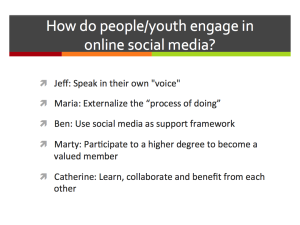Over the past decade, learning environment has been characterized more and more by learners seamlessly switching “between different contexts, such as between formal and informal contexts and between individual and social learning, and by extending the social spaces in which learners interact with each other” (Looi et al, 2010, pp. 154). The portability, social interactivity and versatility of mobile devices have, without a doubt, been a main factor contributing to and promoting this type of learning environment. The authors strongly emphasized that when mobile technology is used for teaching and learning, there is the definite need to also facilitate for collaboration and sharing. Mobile devices are unique in how they could support student-centered learning and the different kinds of interactions and learning environments. This is also in line with Sharples (2013, pp. 5) who articulated the research finding that mobile technology when used in classrooms cultivates an interactive and collaborative environment where learners have shown significantly higher achievement and motivation. Kearney et al (2012)’s pedagogical framework further reinforced the importance of collaboration by providing insights that mobile learning experiences can greatly be amplified by enforcing social collaborative activities with other learners and teachers in face-to-face and virtual conversations.
Designing educational environments that use mobile technologies as learning tools
When mobile devices are used mindfully and with purpose with the right settings and activities, research findings show that these devices can bridge learning in- and outside of the classrooms and amplify learners’ engagement with the course content.
The context for the settings and activities is a key tenet that will be used in the plan to integrate mobile technology by providing the framework of relevance for learners to learn seamlessly, bridging the learning in- and outside of classrooms, developing connections not just with the topic at hand but also with other learners. Bransford et al (2006, pp. 210) looked at links between implicit learning and the brain, informal learning, and formal learning and their impact on effective learning, and saw that context was a key critical factor in learning. The authors indicated that there are two types of contexts: (1) setting-based, and (2) activities-based in the form of participation and type of interaction (p. 219). In terms of learning using mobile devices, Sharples, Arnedillo-Sanchez, Milrad and Vavoula (2009, pp. 236) also reiterated that “[c]ontext is a central construct of mobile learning. It is continually created by people in interaction with other people, with their surroundings and with everyday tools.”
In addition to the importance of context, setting, and collaborative activities, I have also learned that learning in the 21st century is not just about consuming information or knowledge. Mancabelli and Richardson (2011, pp. 55) and Jenkins (2006, pp. 4) described learning in the 21st century as involving new emerging media literacy and participatory culture that allow learners to move up the spectrum from learners who make connections as consumers to those who make connections as creators and producers in the online network. White & Martin (2014, pp. 64) similarly described the spectrum of digital consumers and producers by categorizing the use of mobile devices into four basic practices: (1) capturing and collecting information, (2) communicating and collaborating with others, (3) consuming and critiquing media, and (4) constructing and crating personal forms of representation and expression.
I will base much of the context, settings and activities for my technology integration plan on some of the ideas conveyed by Kamarainen et al (2013) and White & Martin (2014) where the authors described the findings of their empirical-based research (field trip and in-class activities) that showed learners gaining inspiration and significant understanding of science and math concepts when they used their mobile devices and the appropriate applications to participate and collaborate.
Note: I read 3 articles for this week. Out of the 3, only 1, the White & Martin article could be incorporated in this blog. The other 2 articles are:
- Martin, Pastore & Snider (2012). This article is about designing mobile applications and how product testing is critically important to ensure the product’s functionality and usability meets the users’ needs and expectations.
- Davidson and Carliner (2014). The authors provided research findings on e-Books in educational contexts relating to hardware, applications, attitudes, intellectual property implications.
References:
Bransford, J., Vye, N., Stevens, R., Kuhl, P., Schwartz, D., Bell, P., … Sabelli, N. (2006). Learning theories and education: Toward a decade of synergy. In P. A. Alexander & P. H. Winne (Eds.), Handbook of educational psychology (2nd ed., pp. 209–244). Mahwah, NJ: Lawrence Elerbaum Associates.
Davidson, A.-L. & Carliner, S. (2014). e-Books for educational uses, Handbook of research on educational communications and technology, pp. 713-722.
Jenkins, H. (2006). Confronting the challenges of participatory culture: Media education for the 21st century, The John D. and Catherine T. MacArthur foundation reports on digital media and learning, pp. 1-4.
Kamarainen, A. M., Metcalf, S., Grotzer, T., Browne, A., Mazzuca, D., Tutwiler, M. S., & Dede, C. (2013). Ecomobile: Integrating augmented reality and probeware with environmental education field trips, Computers & education, 68, pp. 545-556.
Kearney, M., Schuck, S., Burden, K., & Aubusson, P. (2012). Viewing mobile learning from a pedagogical perspective, Research in learning technology, 20:1, 1-17.
Looi, C.-K., Seow, P., Zhang, B., So, H.-J., Chen, W., & Wong, L.-H. (2010). Leveraging mobile technology for sustainable seamless learning: A research agenda, British journal of educational technology, 41(2), pp. 154-169.
Mancabelli, R., Richardson, W. (2011). Becoming a networked learner, personal learning networks: Using the power of connections to transform education, pp. 33-57.
Martin, F., Pastore, R., & Snider, J. (2012). Developing mobile based instruction, pp. 46-51.
Sharples, M. (2013). Mobile learning: research, practice and challenges. Distance education in China, 3(5), pp. 5-11.
Sharples, M., Arnedillo-Sanchez, I., Milrad, M., & Vavoula, G. (2009). Mobile learning: Small devices, big issues. In N. Balacheff, S. Ludvigsen, T. Jong, A. Lazonder, & S. Barnes (Eds.), Technology-enhanced learning, pp. 233-249.
White, T., & Martin, L. (2014). Mathematics and mobile learning, pp. 64-70.






